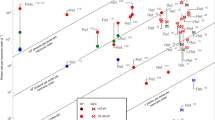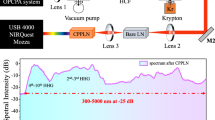Abstract
Ultrafast laser oscillators have become ubiquitous in science and technology. For many years, however, their pulse energy has been limited to the nanojoule regime. Applications requiring more intense pulses relied on complex amplifier systems, which typically operate at low pulse repetition rates of the order of kilohertz. Recently, the pulse energy of femtosecond laser oscillators has greatly increased, such that some of these experiments can now be driven at multimegahertz repetition rates, which opens promising new avenues for many applications. We review the current state of the art of high-energy femtosecond laser oscillators, in particular mode-locked thin-disk lasers, and discuss their potential to drive high-field science experiments at multimegahertz repetition rates.
This is a preview of subscription content, access via your institution
Access options
Subscribe to this journal
Receive 12 print issues and online access
$209.00 per year
only $17.42 per issue
Buy this article
- Purchase on Springer Link
- Instant access to full article PDF
Prices may be subject to local taxes which are calculated during checkout





Similar content being viewed by others
References
Steinmeyer, G. et al. Frontiers in ultrashort pulse generation: Pushing the limits in linear and nonlinear optics. Science 286, 1507–1512 (1999).
McPherson, A. et al. Studies of multiphoton production of vacuum-ultraviolet radiation in the rare gases. J. Opt. Soc. Am. B 4, 595–601 (1987).
Ferray, M. et al. Multiple-harmonic conversion of 1064 nm radiation in rare gases. J. Phys. B 21, L31–L35 (1988).
Paul, P. M. et al. Observation of a train of attosecond pulses from high harmonic generation. Science 292, 1689–1692 (2001).
Agostini, P. & DiMauro, L. F. The physics of attosecond light pulses. Rep. Prog. Phys. 67, 813–855 (2004).
Liu, X., Du, D. & Mourou, G. Laser ablation and micromachining with ultrashort laser pulses. IEEE J. Quant. Electron. 33, 1706–1716 (1997).
von der Linde, D., Sokolowski-Tinten, K. & Bialkowski, J. Laser-solid interactions in the femtosecond time regime. Appl. Surf. Sci. 109–110, 1–10 (1997).
Chao, W., Harteneck, B. D., Liddle, A., Anderson, E. H. & Attwood, D. T. Soft-X-ray microscopy at a spatial resolution better than 15 nm. Nature 435, 1210–1213 (2005).
Koralek, J. D. et al. Laser based angle-resolved photoemission, the sudden approximation, and quasiparticle-like spectral peaks in Bi2Sr2CaCu2O8+δ. Phys. Rev. Lett. 96, 017005 (2006).
Dewald, S. et al. Ionization of noble gases with pulses directly from a laser oscillator. Opt. Lett. 31, 2072–2074 (2006).
Marchese, S. V. et al. in Conf. Lasers and Electro-Optics (Europe), Munich, Germany CF3-2-MON (2007).
Marchese, S. V. et al. Femtosecond thin disk laser oscillator with pulse energy beyond the 10-microjoule level. Opt. Express 16, 6397–6407 (2008).
Neuhaus, J. et al. Passively mode-locked Yb:YAG thin-disk laser with pulse energies exceeding 13 μJ by use of an active multipass geometry. Opt. Lett. 33, 726–728 (2008).
Neuhaus, J. et al. in Proc. Ultrafast Phenomena XVI (eds P. B. Corkum et al.) (in the press).
Südmeyer, T. et al. in Proc. Ultrafast Phenomena XVI (eds P. B. Corkum et al.) (in the press).
Röser, F. et al. 131 W 220 fs fiber laser system. Opt. Lett. 30, 2754–2756 (2005).
Röser, F. et al. 90 W average power 100 μJ energy femtosecond fiber chirped-pulse amplification system. Opt. Lett. 32, 2230–2232 (2007).
Shah, L., Fermann, M. E., Dawson, J. W. & Barty, C. P. J. Micromachining with a 50 W, 50 μJ, sub-picosecond fiber laser system. Opt. Express 14, 12546–12551 (2006).
Limpert, J. et al. High-power rod-type photonic crystal fiber laser. Opt. Express 13, 1055–1058 (2005).
Galvanauskas, A., Swan, M. C. & Liu, C.-H. in Conf. Lasers and Electro-Optics (CLEO), San Jose, USA CMB1 (2008).
Spence, D. E., Kean, P. N. & Sibbett, W. 60-fsec pulse generation from a self-mode-locked Ti:sapphire laser. Opt. Lett. 16, 42–44 (1991).
Keller, U. et al. Solid-state low-loss intracavity saturable absorber for Nd:YLF lasers: An antiresonant semiconductor Fabry–Perot saturable absorber. Opt. Lett. 17, 505–507 (1992).
Keller, U. Recent developments in compact ultrafast lasers. Nature 424, 831–838 (2003).
Liu, Z. et al. High-repetition-rate, high-average-power, mode-locked Ti:sapphire laser with an intracavity continuous-wave amplification scheme. Appl. Phys. Lett. 74, 3622–3623 (1999).
Kafka, J. D., Watts, M. L. & Pieterse, J.-W. J. Picosecond and femtosecond pulse generation in a regeneratively modelocked Ti:sapphire laser. IEEE J. Quant. Electron. 28, 2151–2162 (1992).
Naumov, S. et al. Approaching the microjoule frontier with femtosecond laser oscillators. New J. Phys. 7, 216 (2005).
Herriott, D., Kogelnik, H. & Kompfner, R. Off-axis paths in spherical mirror interferometers. Appl. Opt. 3, 523–526 (1964).
Aus der Au, J. et al. 16.2 W average power from a diode-pumped femtosecond Yb:YAG thin disk laser. Opt. Lett. 25, 859–861 (2000).
Giesen, A. et al. Scalable concept for diode-pumped high-power solid-state lasers. Appl. Phys. B 58, 365–372 (1994).
Innerhofer, E. et al. 60 W average power in 810-fs pulses from a thin-disk Yb:YAG laser. Opt. Lett. 28, 367–369 (2003).
Brunner, F. et al. Powerful red-green-blue laser source pumped with a mode-locked thin disk laser. Opt. Lett. 29, 1921–1923 (2004).
Kärtner, F. X. & Keller, U. Stabilization of soliton-like pulses with a slow saturable absorber. Opt. Lett. 20, 16–18 (1995).
Marchese, S. V. et al. Pulse energy scaling to 5 μJ from a femtosecond thin disk laser. Opt. Lett. 31, 2728–2730 (2006).
Giesen, A. & Speiser, J. Fifteen years of work on thin-disk lasers: Results and scaling laws. IEEE J. Sel. Top. Quant. 13, 598–609 (2007).
Mende, J. et al. in Solid State Lasers XVII: Technology and Devices, Proc. SPIE (eds Clarkson, W. A., Hodgson, N. & Shori, R. K.) 6871, 68710M–68711 (2008).
Palmer, G., Siegel, M., Steinmann, A. & Morgner, U. Microjoule pulses from a passively mode-locked Yb:KY(WO4)2 thin-disk oscillator with cavity dumping. Opt. Lett. 32, 1593–1595 (2007).
Sutter, D. H. et al. Semiconductor saturable-absorber mirror-assisted Kerr-lens mode-locked Ti:sapphire laser producing pulses in the two-cycle regime. Opt. Lett. 24, 631–633 (1999).
Morgner, U. et al. Sub-two-cycle pulses from a Kerr-lens mode-locked Ti:sapphire laser. Opt. Lett. 24, 411–413 (1999).
Brunner, F. et al. 240-fs pulses with 22-W average power from a mode-locked thin-disk Yb:KY(WO4)2 laser. Opt. Lett. 27, 1162–1164 (2002).
Peters, R., Kränkel, C., Petermann, K. & Huber, G. Broadly tunable high-power Yb:Lu2O3 thin disk laser with 80% slope efficiency. Opt. Express 15, 7075–7082 (2007).
Griebner, U., Petrov, V., Petermann, K. & Peters, V. Passively mode-locked Yb:Lu2O3 laser. Opt. Express 12, 3125–3130 (2004).
Marchese, S. V. et al. Efficient femtosecond high power Yb:Lu2O3 thin disk laser. Opt. Express 15, 16966–16971 (2007).
Krankel, C. et al. Continuous-wave high power laser operation and tunability of Yb: LaSc3(BO3)4 in thin disk configuration. Appl. Phys. B 87, 217–220 (2007).
Cascales, C. et al. Structural, spectroscopic, and tunable laser properties of Yb3+-doped NaGd(WO4)2 . Phys. Rev. B 74, 174114 (2006).
Grischkowsky, D. & Balant, A. C. Optical pulse compression based on enhanced frequency chirping. Appl. Phys. Lett. 41, 1–3 (1982).
Shank, C. V. et al. Compression of femtosecond optical pulses. Appl. Phys. Lett. 40, 761–763 (1982).
Südmeyer, T. et al. Nonlinear femtosecond pulse compression at high average power levels by use of a large-mode-area holey fiber. Opt. Lett. 28, 1951–1953 (2003).
Innerhofer, E. et al. in Advanced Solid-State Photonics, Wien, Austria TuA3 (2005).
Wong, W. S., Peng, X., McLaughlin, J. M. & Dong, L. Breaking the limit of maximum effective area for robust single-mode propagation in optical fibers. Opt. Lett. 30, 2855–2857 (2005).
Dong, L., Li, J. & Peng, X. Bend-resistant fundamental mode operation in ytterbium-doped leakage channel fibers with effective areas up to 3160 μm2. Opt. Express 14, 11512–11519 (2006).
Hauri, C. P. et al. Generation of intense, carrier-envelope phase-locked few-cycle laser pulses through filamentation. Appl. Phys. B 79, 673–677 (2004).
Helm, H. et al. Images of photoelectrons formed in intense laser fields. Phys. Rev. Lett. 70, 3221 (1993).
Helm, H. & Dyer, M. J. Resonant and nonresonant multiphoton ionization of helium. Phys. Rev. A 49, 2726–2733 (1994).
Schyja, V., Lang, T. & Helm, H. Channel switching in above-threshold ionization of xenon. Phys. Rev. A 57, 3692–3697 (1998).
Wiehle, R. & Witzel, B. Correlation between double and nonresonant single ionization. Phys. Rev. Lett. 89, 223002 (2002).
Wiehle, R., Witzel, B., Helm, H. & Cormier, E. Dynamics of strong-field above-threshold ionization of argon: Comparison between experiment and theory. Phys. Rev. A 67, 063405 (2003).
Weber, T. et al. Correlated electron emission in multiphoton double ionization. Nature 405, 658–661 (2000).
Jones, R. J., Moll, K. D., Thorpe, M. J. & Ye, J. Phase-coherent frequency combs in the vacuum ultraviolet via high-harmonic generation inside a femtosecond enhancement cavity. Phys. Rev. Lett. 94, 193201 (2005).
Gohle, C. et al. A frequency comb in the extreme ultraviolet. Nature 436, 234–237 (2005).
Hartl, I. et al. Cavity-enhanced similariton Yb-fiber laser frequency comb: 3×1014 W/cm2 peak intensity at 136 MHz. Opt. Lett. 32, 2870–2872 (2007).
Yost, D. C., Schibli, T. R. & Ye, J. in Conf. Lasers and Electro-Optics (CLEO), San Jose, California CPDA10 (2008).
Gibson, E. A. et al. Coherent soft X-ray generation in the water window with quasi-phase matching. Science 302, 95–98 (2003).
Zhou, X. B., Kapteyn, H. & Murnane, M. Positive-dispersion cavity-dumped Ti: sapphire laser oscillator and its application to white light generation. Opt. Express 14, 9750–9757 (2006).
Killi, A. et al. High-peak-power pulses from a cavity-dumped Yb:KY(WO4)2 oscillator. Opt. Lett. 30, 1891–1893 (2005).
Killi, A. et al. High speed electro-optical cavity dumping of mode-locked laser oscillators. Opt. Express 13, 1916–1922 (2005).
Holtom, G. R. Mode-locked Yb:KGW laser longitudinally pumped by polarization-coupled diode bars. Opt. Lett. 31, 2719–2721 (2006).
Cho, S. H., Bouma, B. E., Ippen, E. P. & Fujimoto, J. G. Low-repetition-rate high-peak-power Kerr-lens mode-locked Ti:Al2O3 laser with a multiple-pass cavity. Opt. Lett. 24, 417–419 (1999).
Author information
Authors and Affiliations
Corresponding author
Rights and permissions
About this article
Cite this article
Südmeyer, T., Marchese, S., Hashimoto, S. et al. Femtosecond laser oscillators for high-field science. Nature Photon 2, 599–604 (2008). https://doi.org/10.1038/nphoton.2008.194
Issue Date:
DOI: https://doi.org/10.1038/nphoton.2008.194
This article is cited by
-
Experimental study on the ablation of stainless steel using multiple ultra-short laser pulses with tunable time delays
Applied Physics A (2023)
-
The amazing progress of high-power ultrafast thin-disk lasers
Journal of the European Optical Society-Rapid Publications (2019)
-
Room temperature continuous-wave excited biexciton emission in perovskite nanoplatelets via plasmonic nonlinear fano resonance
Communications Physics (2019)
-
Diode-pumped Yb:KGW laser with 73 fs pulse and 0.72 MW peak power based on Kerr-lens mode locking
Applied Physics B (2019)
-
Influence of cavity parameters on pulse properties of dual wavelength Yb:YAG mode-locked laser
Optical and Quantum Electronics (2016)



